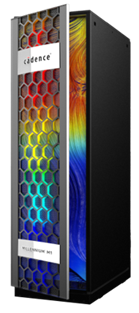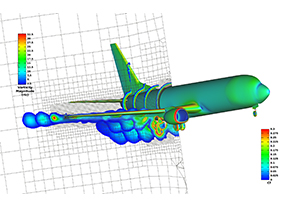Large Eddy Simulation
Large Eddy Simulation (LES) is a computational fluid dynamics (CFD) technique that simulates turbulent flows. LES is based on the idea that large turbulent eddies contain most of the energy of a turbulent flow, while smaller eddies dissipate that energy as heat. In LES, the large eddies are resolved directly, while the smaller eddies are modeled using subgrid-scale models. LES is particularly useful for simulating flows with high Reynolds numbers characterized by large turbulent eddies. Examples of such flows include atmospheric boundary layer flows, jet flows, and internal combustion engine flows.
LES can also study complex flow phenomena, such as vortex shedding, flow separation, and turbulence-induced noise. Compared to other CFD techniques, LES requires a finer computational mesh and higher computational resources. However, it provides more accurate results and allows studying complex flow phenomena.
What is the significance of LES in CFD Simulation?
Large Eddy Simulation (LES) is important in various industries, particularly aerospace and automotive. Engineers can study and analyze complex turbulent flows and develop more efficient aircraft, engines, and vehicle designs. LES also helps improve the performance and safety of industrial processes, such as combustion and heat transfer. By providing more accurate results, LES reduces the need for physical testing and experimentation, resulting in cost savings and faster time-to-market for new products. Overall, using LES in industry has revolutionized how engineers approach fluid dynamics problems, leading to significant advancements in various fields.
What is the workflow of an LES Simulation?
LES requires a detailed understanding of the fluid domain, boundary conditions, and initial states that would be directly or indirectly affected by turbulence. Here is a simplified breakdown of the LES process:
- Grid Generation: A robust and finely tuned grid is critical for LES. The computational mesh must resolve the large eddies—the primary focus of LES—and the small-scale structures captured by SGS models.
- Initial Conditions: The flow field at the onset of the simulation reflects real or expected system states. The accuracy of these initial conditions significantly influences the reliability of the simulation's results.
- Subgrid-Scale Model: These models, such as the Smagorinsky model, approximate the impact of unresolved turbulent eddies, contributing to the simulation by adding relevant turbulence kinetic energy and dissipation.
- Simulation and Analysis: The LES solver time-marches through the simulated domain, solving the filtered Navier-Stokes equations at every timestep. Engineers analyze the data, often through post-processing visualization tools, to extract relevant information about the flow's behavior and characteristics.
LES with Cadence Products
Cadence Fidelity LES Solver is the industry’s first high-fidelity computational fluid dynamics (CFD) solver that expands the practical application of LES to a broad range of engineering applications in aerospace, automotive, and turbomachinery. It accurately predicts traditionally complex problems for CFD in aeroacoustics, aerodynamics, combustion, heat transfer, and multiphase, designed to tackle the toughest challenges in fluid dynamics.
The Fidelity LES software introduces a paradigm shift in the industry by enabling the use of both computer processing units (CPUs) and graphical processing units (GPUs), which reduces the turnaround time for LES simulations from days to hours. The solver has been optimized to consume as little memory as possible and scales linearly to hundreds of GPUs across dozens of nodes.
Cadence Millennium M1 is a software/hardware combined solution, the industry’s first CFD supercomputer. This supercomputer has several benefits, such as improved accuracy, speed, and scalability. It can deliver up to 100X impact on design and offer near-linear scaling across multiple applications. This allows predictive CFD to run ahead of production testing.
With the help of GPU compute and modern CFD solvers, this system can carry out high-performance CFD design and optimize the process. This system is flexible and scalable. Customers can deploy it on-premises or in the cloud, and it’s compatible with the GPUs of leading vendors. This makes it an extremely versatile solution that can cater to customers of any size and computing requirements.


